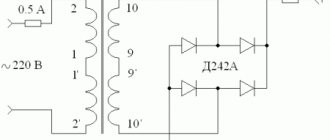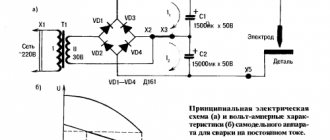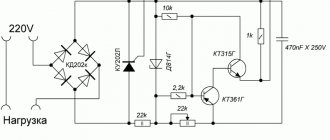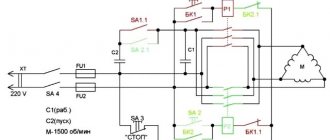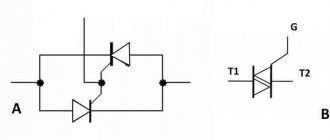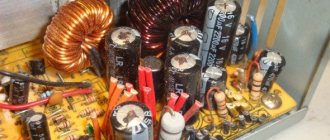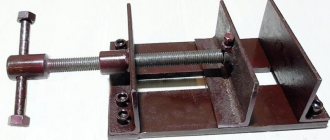We consider simple circuits of digital voltmeter and ammeter, built without the use of microcontrollers on the CA3162, KR514ID2 microcircuits. Typically, a good laboratory power supply has built-in instruments - a voltmeter and an ammeter. A voltmeter allows you to accurately set the output voltage, and an ammeter will show the current through the load.
Old laboratory power supplies had dial indicators, but now they should be digital. Nowadays, radio amateurs most often make such devices based on a microcontroller or ADC chips like KR572PV2, KR572PV5.
Chip CA3162E
But there are other microcircuits of similar action. For example, there is a CA3162E microcircuit, which is designed to create an analog value meter with the result displayed on a three-digit digital indicator.
The CA3162E microcircuit is an ADC with a maximum input voltage of 999 mV (with readings “999”) and a logic circuit that provides information about the measurement result in the form of three alternately changing binary-decimal four-bit codes on a parallel output and three outputs for polling the bits of the dynamic circuit indication.
To get a complete device, you need to add a decoder to work on a seven-segment indicator and an assembly of three seven-segment indicators included in the matrix for dynamic display, as well as three control keys.
The type of indicators can be any - LED, fluorescent, gas-discharge, liquid crystal, it all depends on the circuit of the output node on the decoder and keys. It uses LED indication on a display consisting of three seven-segment indicators with common anodes.
The indicators are connected according to a dynamic matrix circuit, that is, all their segment (cathode) pins are connected in parallel. And for interrogation, that is, sequential switching, common anode terminals are used.
Improved heat dissipation
The first drawback that plagues the vast majority of inexpensive inverter devices is a poor heat removal system from power switches and rectifier diodes. It is better to begin improvements in this direction by increasing the intensity of forced airflow. As a rule, case fans are installed in welding machines, powered by 12 V service circuits. In “compact” models, forced air cooling may be completely absent, which is certainly nonsense for electrical equipment of this class.
It is enough to simply increase the air flow by installing several of these fans in series. The problem is that the “original” cooler will most likely have to be removed. To operate effectively in a sequential assembly, fans must have an identical shape and number of blades, as well as rotation speed. Assembling identical coolers into a “stack” is extremely simple; just tighten them with a pair of long bolts along diametrically opposite corner holes. Also, do not worry about the power of the service power supply; as a rule, it is enough to install 3–4 fans.
Schematic diagram of a voltmeter
Now closer to the diagram. Figure 1 shows a circuit of a voltmeter that measures voltage from 0 to 100V (0...99.9V). The measured voltage is supplied to pins 11-10 (input) of microcircuit D1 through a divider on resistors R1-R3.
Capacitor C3 eliminates the influence of interference on the measurement result. Resistor R4 sets the instrument readings to zero; in the absence of input voltage, and resistor R5 sets the measurement limit so that the measurement result corresponds to the real one, that is, we can say that they calibrate the device.
Rice. 1. Schematic diagram of a digital voltmeter up to 100V on SA3162, KR514ID2 microcircuits.
Now about the outputs of the microcircuit. The logical part of the CA3162E is built using TTL logic, and the outputs are also with open collectors. At the outputs “1-2-4-8” a binary decimal code is generated, which changes periodically, providing sequential transmission of data on three digits of the measurement result.
If a TTL decoder is used, such as KR514ID2, then its inputs are directly connected to these inputs of D1. If a CMOS or MOS logic decoder is used, then its inputs will need to be pulled to positive using resistors. This will need to be done, for example, if the K176ID2 or CD4056 decoder is used instead of KR514ID2.
The outputs of the decoder D2 are connected through current-limiting resistors R7-R13 to the segment terminals of the LED indicators H1-NC. The same segment pins of all three indicators are connected together. To poll the indicators, transistor switches VT1-VT3 are used, to the bases of which commands are sent from the outputs H1-NC of the D1 chip.
These conclusions are also made according to an open collector circuit. Active zero, so transistors of the pnp structure are used.
AC Modifications
You can make an AC ammeter (digital) yourself. Microcontrollers in the models are used with rectifiers. To increase the measurement accuracy, broadband filters are used. The shunt resistance in this case should not be less than 2 ohms. The sensitivity of resistors must be 3 microns. Stabilizers are most often installed of the expansion type. It is also important to note that you will need a triode for assembly. It must be soldered directly to the comparator. The permissible error of devices of this type fluctuates around 0.2%.
Schematic diagram of an ammeter
The ammeter circuit is shown in Figure 2. The circuit is almost the same except for the input. Here, instead of a divider, there is a shunt on a five-watt resistor R2 with a resistance of 0.1 Ot. With such a shunt, the device measures current up to 10A (0...9.99A). Zeroing and calibration, as in the first circuit, is carried out by resistors R4 and R5.
Rice. 2. Schematic diagram of a digital ammeter up to 10A or more on SA3162, KR514ID2 microcircuits.
By selecting other dividers and shunts, you can set other measurement limits, for example, 0...9.99V, 0...999mA, 0...999V, 0...99.9A, this depends on the output parameters of the laboratory power supply in which these indicators will be installed. Also, based on these circuits, you can make an independent measuring device for measuring voltage and current (desktop multimeter).
It should be taken into account that even using liquid crystal indicators, the device will consume significant current, since the logical part of the CA3162E is built using TTL logic. Therefore, it is unlikely that you will get a good self-powered device. But a car voltmeter (Fig. 4) will turn out to be quite good.
The devices are powered by a constant stabilized voltage of 5V. The power source in which they will be installed must provide for the presence of such a voltage at a current of at least 150mA.
How to connect a voltammeter to a charger - a selection of diagrams
Figures 4.3 and 4.4 show circuits for connecting a voltmeter and an ammeter through voltage (VT) and current (CT) measuring transformers, respectively.
?/,, U2_
primary and secondary voltages of VT;
Wv W2
- primary and secondary windings of the voltage transformer;
V
- voltmeter
Rice.
4.4. Measuring current transformer.
Ammeter connection diagram: /p /2 - primary and secondary currents of the CT; Wv W2
— primary and secondary windings of the CT;
A
- ammeter
It is impossible to connect an ammeter to a current source (power supply) without a load, since in this case a large current will pass through its winding and it may burn out. For the same reason, the ammeter cannot be connected in parallel with the load.
Each ammeter is designed for a certain maximum current, above which the ammeter may burn out. If you need to use an ammeter to measure a current that exceeds the permissible current for a given ammeter, then a shunt is connected in parallel to the ammeter, i.e. expand the ammeter's measurement limits.
A shunt represents a relatively small but precisely known resistance. The circuit diagram for connecting an ammeter with a shunt is shown in Fig. 4.5, a.
The shunt must have four terminals to eliminate the influence of transient contact resistances on the shunt resistance. Shunts are made from manganin, an alloy whose temperature coefficient of resistance is practically zero.
Rice.
4.5. Ammeter connection diagram:
a -
with shunt;
6
- through a current transformer;
for circuit a: 1 -
shunt;
2
- load;
for scheme b: 1
— measuring current transformer;
2
- load
Rice. 4.6. Connection diagram of three ammeters through two current transformers:
L j and L2 - the beginning and end of the primary winding of the current transformer; And, and I2 - the beginning and end of the secondary winding of the current transformer; L
- ammeters;
iA, iB, ic -
currents in phases
Rice.
4.7. Voltmeter connection diagram:
Figure 4.6 shows a diagram of connecting three ammeters through two current transformers.
As can be seen from the diagram, a current iA passes through the first ammeter ,
through the second -
iB,
therefore, the current in the third ammeter, equal to the sum of two linear currents
iA
and
iB,
is equal to the third linear current:
ic = iA
+
iB.
Circuits of homemade digital voltmeter and ammeter (SA3162, KR514ID2)
Measuring shunts are made from manganin. Depending on the design there are:
Expert opinion
It-Technology, Electrical power and electronics specialist
Ask questions to the “Specialist for modernization of energy generation systems”
Shunt for ammeter. Or how to make a voltmeter from an ammeter and vice versa. Power supplies - Catalog of articles - Fundamentals of robotics L j and L 2 the beginning and end of the primary winding of the current transformer; And, and And 2 the beginning and end of the secondary winding of the current transformer; L ammeters; i A, i B, ic currents in phases. Ask, I'm in touch!
Connecting the device
Figure 3 shows a diagram of connecting meters in a laboratory source.
Rice. 3. Connection diagram of meters in a laboratory source.
Fig.4. Homemade automobile voltmeter on microcircuits.
Galvanometers (analog meters)
Analog meters have needles that rotate to mark numbers on a scale. This distinguishes them from digital devices that display digital symbols directly on the screen. At the center of most analog instruments is the galvanometer (G). Current passes through it and causes proportional movement (needle deflection).
A galvanometer is characterized by resistance and current sensitivity. The latter is the current that causes a significant deflection of the galvanometer needle (maximum current). For example, a galvanometer whose current sensitivity is 50 μA reaches a maximum deflection of 50 μA.
If such a device has a resistance of 20 ohms, then only the voltage V = IR = (50 µA) (25 ohms) = 1.25 mV creates a full-scale reading. By combining resistors with it, you can consider it as a voltmeter or ammeter.
Details
Perhaps the most difficult to obtain are the CA3162E microcircuits. Of the analogues, I know only NTE2054. There may be other analogues that I am not aware of.
The rest is much easier. As already said, the output circuit can be made using any decoder and corresponding indicators. For example, if the indicators have a common cathode, then you need to replace KR514ID2 with KR514ID1 (the pinout is the same), and drag the transistors VT1-VT3 down, connecting their collectors to the power supply negative, and the emitters to the common cathodes of the indicators. You can use CMOS logic decoders by connecting their inputs to the power supply positive using resistors.
DMK models
Digital ammeters and voltmeters of this company are in great demand. The range of this company includes many stationary models. If we consider voltmeters, they can withstand a maximum pressure of 35 kPa. In this case, transistors are used of the toroidal type.
Microcontrollers are usually installed with converters. Devices of this type are ideal for laboratory research. Digital ammeters and voltmeters of this company are manufactured with protected housings.
↑ Files
Datasheet for ICL7107
